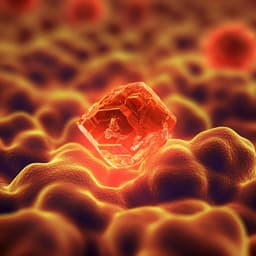
Physics
Chemical shielding of H₂O and HF encapsulated inside a C₆₀ cage
S. P. Jarvis, H. Sang, et al.
Discover how Samuel P. Jarvis and colleagues unveil the dynamic interaction between H₂O and HF molecules encapsulated in a C₆₀ fullerene cage, revealing intriguing off-center locations and significant rotational motion, while retaining chemical isolation from the fullerene's frontier orbitals.
~3 min • Beginner • English
Introduction
The study of how encapsulated molecules respond to external electrostatic environments is central to understanding endohedral fullerenes, which find applications in nanoelectronics, quantum information, and as contrast agents. C60 has been proposed to act as a Faraday cage that screens internal species from external fields, but the degree of electrostatic decoupling is unresolved. Molecular surgery has enabled synthesis of H2O@C60 and HF@C60, where the internal species are free and isolated. Prior observations, including ortho–para spin conversion detected by multiple spectroscopies and even electrical measurements in bulk crystals, suggest that encapsulated molecules can influence their environment despite supposed shielding. Conflicting theoretical reports exist on charge transfer and electrostatic isolation. This work directly measures the intra-cage positions of H2O and HF within adsorbed C60 using NIXSW, complemented by STM, nc-AFM, VB-XPS, DFT, and MD, to test the Faraday cage hypothesis and quantify how adsorption-induced fields affect encapsulated molecules.
Literature Review
The paper reviews prior work on endohedral fullerenes and their applications, including electronic components, qubits, and imaging agents. It cites proposals that C60 behaves as a Faraday cage, screening internal species, and notes mixed theoretical predictions regarding charge transfer and electrostatic isolation of H2O@C60. Experimental studies have observed ortho–para nuclear spin conversion and rotational coherence of encapsulated water via NMR, IR, THz spectroscopy, and even temperature-dependent capacitance, implying coupling to the external environment. HF@C60 synthesis provides a comparative system due to similar dipole moments to H2O. Surface adsorption of C60 on metal substrates (Ag(111), Cu(111)) is known to induce reconstructions and mixed adsorption sites (atom-top and vacancy), complicating structural interpretation. Prior LEED and DFT work suggests a (2√3×2√3)R30° superlattice on Ag(111) with a mixture of adsorption sites.
Methodology
- Samples and microscopy: Mixed monolayers (typically 70:30 C60:H2O@C60) were prepared on clean sputter-annealed Cu(111) for scanning probe experiments. Endohedral fullerenes were deposited by thermal sublimation under UHV (<1×10^-10 mbar). STM and constant-height nc-AFM were performed at 5 K using a Createc LT STM-AFM with a qPlus sensor (f0 ≈ 20 kHz, Q ≈ 30,000, k ≈ 1800 N/m). Imaging parameters included STM at 1.5 V/10 pA; nc-AFM oscillation amplitude a0 = 300 pm, V = −2.1 mV.
- Photoemission: Valence band XPS (VB-XPS) was acquired at Diamond Light Source (I09 beamline) at hν = 110 eV on thick films (~95% pure H2O@C60) to compare with empty C60.
- NIXSW and core-level XPS: NIXSW was performed at the Ag(111) Bragg energy (hν ≈ 2.637 keV) on monolayer films of H2O@C60 and HF@C60 adsorbed on Ag(111) prepared by sputter-anneal and thermal deposition. O 1s (hν = 700 eV) and F 1s (hν = 900 eV) spectra confirmed encapsulation and were used for relative absorption in NIXSW fits. Measurements were taken from 20–200 K while minimizing beam damage by detuning the beam and scanning across the surface. LEED verified (2√3×2√3)R30° ordering.
- NIXSW analysis: Coherent position (Pc) and coherent fraction (Fc) were extracted by fitting the relative absorption vs. energy around the Bragg condition. z111 heights were derived from Pc.
- DFT geometry optimization: VASP and CP2K were used with PBE exchange–correlation and Grimme DFT-D3 dispersion. The Ag(111) slab had 4 layers with the bottom two fixed. Two adsorption geometries were modeled: atom-top and single-atom vacancy, with a C60 hexagon parallel to the surface. Single-molecule and (2√3×2√3)R30° supercell calculations provided comparable adsorption heights. Forces converged to <0.01 eV/Å.
- MD simulations: Conducted in CP2K (Quickstep) with Gaussian/plane-wave basis (triple-zeta MOLOPT), GTH pseudopotentials, PBE-D3. Time step 0.5 fs; NVT used; statistics collected after 0.3 ps; temperature 180 K. MD sampled internal configurations of H2O (and HF for validation) within the adsorbed C60 to assess rotational dynamics and average intra-cage positions. Approximate O 1s core-level shifts were estimated following a final-state approach along MD snapshots.
- LEED I(V) modeling: Employed to assess the fraction of atom-top vs. vacancy adsorption sites using DFT-derived coordinates, supporting a mixed adsorption model.
Key Findings
- Electronic structure and mechanical response: STM, nc-AFM (including force–distance), and VB-XPS showed no discernible differences between empty C60 and H2O@C60 across varied imaging parameters. Resonant photoemission at the O K-edge showed no oxygen-derived contribution to the HOMO/HOMO+1, indicating that the encapsulated H2O does not contribute to frontier orbitals of C60.
- NIXSW positions (20 K examples and temperature-averaged values):
• H2O@C60: At 20 K, Pc = 0.35 ± 0.03, Fc = 0.78 ± 0.05. Averaged over 20–200 K, Pc = 0.36 ± 0.01, Fc = 0.72 ± 0.06, yielding z111(O) = 5.57 ± 0.03 Å above Ag(111).
• HF@C60: At 20 K, Pc = 0.43 ± 0.03, Fc = 0.72 ± 0.07. Averaged over 20–200 K, Pc = 0.40 ± 0.05, Fc = 0.62 ± 0.07, yielding z111(F) = 5.7 ± 0.1 Å.
These heights place the encapsulated atoms close to, but not exactly at, the cage center.
- DFT-PBE-D3 geometries predict off-center internal molecules driven by adsorption-induced intra-cage electrostatic fields:
• Vacancy site: bottom C60 layer 1.89 Å above top Ag layer; cage center at 5.17 Å. Predicted O at 5.03 Å (0.14 Å closer to surface than center), F at 5.24 Å (0.07 Å farther from surface).
• Atom-top site: predicted O at 5.43 Å. Both predictions differ from NIXSW average, implicating dynamic and static disorder.
- MD at 180 K shows substantial internal rotational motion with average height increases of ~0.3 Å relative to the DFT ground state: yielding average O heights of ~5.33 Å (vacancy) and ~5.73 Å (atom-top), consistent with the experimental z111(O) when considering a mixed-site film.
- Evidence of intra-cage electric field from spectroscopy:
• O 1s FWHM broadens from ~0.7 eV (bulk H2O@C60) to ~1.0 eV (chemisorbed monolayer) and the binding energy shifts by ~+0.20 eV relative to Ag 3d, attributed to altered screening and inhomogeneous field inside the cage upon adsorption.
• MD-based core-level shift estimates qualitatively reproduce the direction of the binding energy shift (+0.46 eV in calculation vs. +0.20 eV in experiment) and increased broadening (calculated ΔFWHM ~0.1 eV vs. experimental ~0.3 eV).
- Mixed adsorption site model: LEED I(V) and Argand-vector analysis of NIXSW data indicate a mixture of atom-top and vacancy adsorption sites in the (2√3×2√3)R30° monolayer, explaining the experimental Pc and Fc via a weighted combination of calculated positions (5.33 Å and 5.73 Å) and the observed static disorder.
Discussion
The combined STM/nc-AFM/VB-XPS results support strong electronic screening by the C60 cage: encapsulated H2O and HF do not contribute to frontier orbitals, and the cage stiffness and overall electronic structure remain unchanged. However, NIXSW, DFT, MD, and core-level spectroscopy reveal that adsorption of C60 on Ag(111) modifies the electrostatic potential inside the cage, producing an intra-cage field that shifts the average positions of H2O and HF off-center and closer to or farther from the surface depending on molecular polarity and adsorption geometry. The measured atom heights (z111(O) ≈ 5.57 Å; z111(F) ≈ 5.7 Å) are reconciled with theory by accounting for dynamic rotational motion (which raises average heights by ~0.3 Å) and static disorder due to a mixed population of vacancy and atom-top sites. Thus, while orbital-level coupling is negligible (consistent with Faraday-cage-like behavior for electronic states), electrostatic interactions penetrate the cage and influence the spatial distribution and core-level energies of the encapsulated molecules. The Argand analysis highlights that simple, single-site interpretations of NIXSW data are insufficient; instead, a mixed-site model aligns the experimental coherent position and fraction with theoretical predictions.
Conclusion
Encapsulated H2O and HF within C60 exhibit no detectable contributions to the fullerene frontier orbitals, confirming strong electronic decoupling. Nonetheless, adsorption of C60 on Ag(111) induces a significant intra-cage electric field that displaces the encapsulated molecules from the cage center and affects their core-level spectra. Direct measurements via NIXSW place O and F at ~5.6–5.7 Å above Ag(111), consistent with dispersion-corrected DFT predictions once dynamic rotational motion and mixed adsorption sites are considered. These findings resolve aspects of the Faraday-cage debate by distinguishing between electronic screening (strong) and electrostatic field penetration (significant). Future work could target quantitative mapping of intra-cage fields across different substrates and adsorption geometries, time-resolved studies of rotational dynamics, and exploration of other polar encapsulates to generalize the observed behavior.
Limitations
- Mixed adsorption sites (atom-top and vacancy) create static disorder and render the NIXSW analysis under-determined without additional constraints; unique Pc and Fc for each site cannot be directly extracted.
- DFT-PBE-D3 and approximate core-level shift methods provide qualitative but not fully quantitative agreement with experiment (e.g., overestimation of O 1s binding energy shift and smaller predicted broadening).
- MD simulations were limited to 180 K with finite sampling and approximate force fields inherent to DFT-D3; dynamic effects at other temperatures or including anharmonic substrate motion were not fully explored.
- Potential beam damage and extrinsic adsorption had to be mitigated; residual effects could influence core-level linewidths.
- Temperature range for NIXSW (20–200 K) showed minimal variation, but behavior at higher temperatures or under different surface reconstructions was not addressed.
Related Publications
Explore these studies to deepen your understanding of the subject.







